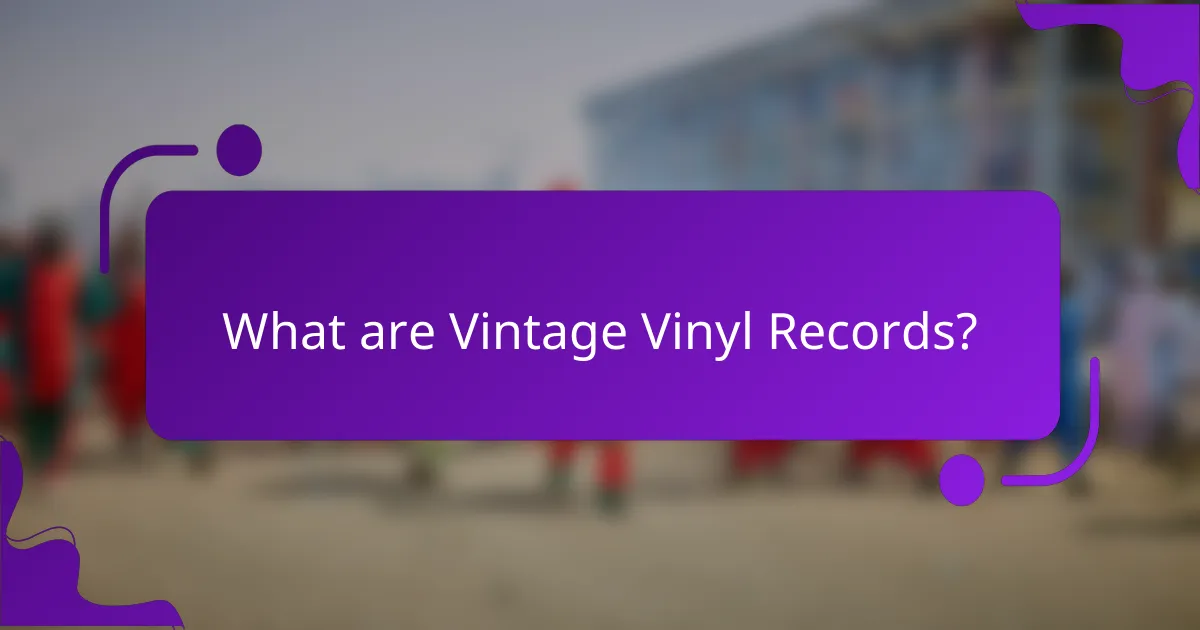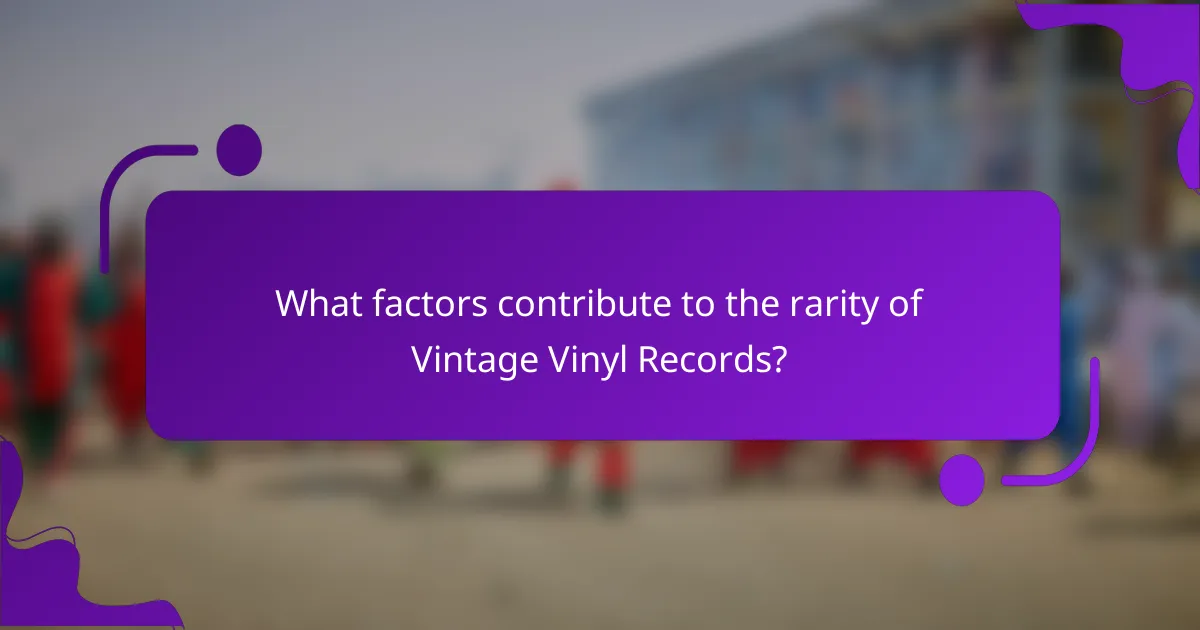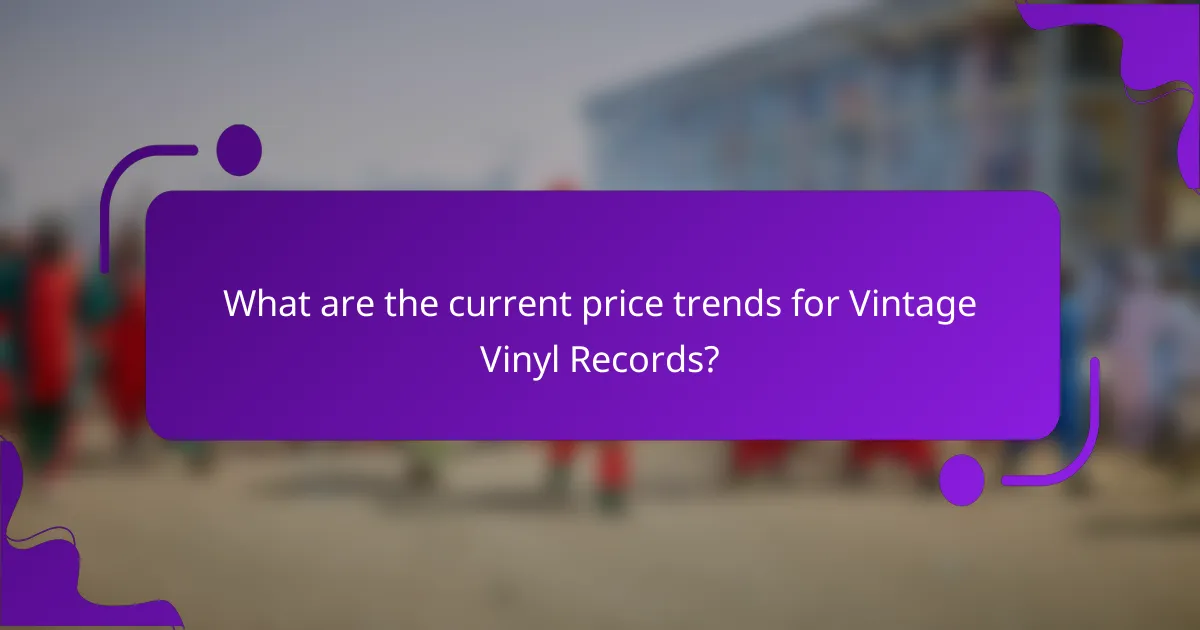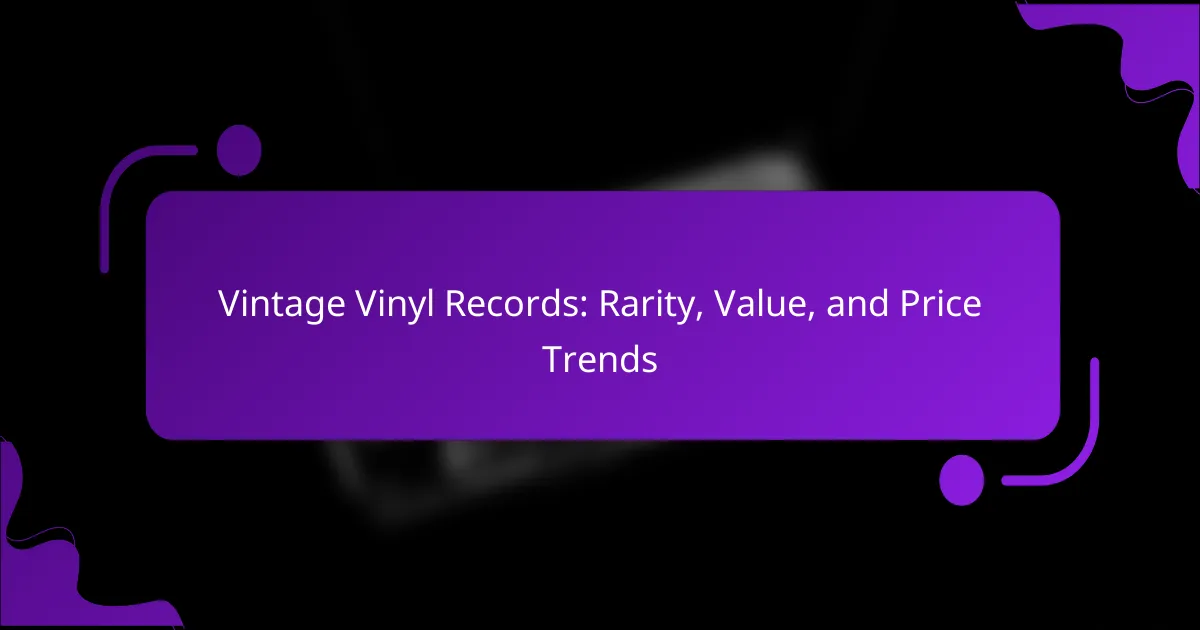Vintage vinyl records are music recordings pressed on vinyl material, typically produced before the 1980s, known for their distinct sound quality and nostalgic appeal. This article explores the rarity and value of vintage vinyl, highlighting factors such as limited production runs, historical significance, and condition, which influence their market worth. It also examines current price trends, noting a significant increase in value driven by collector interest, especially for records from iconic artists like The Beatles and Elvis Presley. Additionally, the popularity of limited edition releases and colored vinyl is discussed, indicating a continued resurgence in the vinyl market.

What are Vintage Vinyl Records?
Vintage vinyl records are music recordings pressed on vinyl material, typically produced before the 1980s. These records are characterized by their unique sound quality and nostalgic appeal. They often feature artwork and packaging that reflects the era of their release. Many collectors seek vintage vinyl for its rarity and historical significance. The production of vinyl records peaked in the mid-20th century, making earlier pressings particularly valuable today. Specific examples include records from iconic artists like The Beatles and Elvis Presley, which can fetch high prices at auctions. Collectors often value the condition, rarity, and demand for specific albums when determining worth.
How did Vintage Vinyl Records become popular?
Vintage vinyl records became popular due to a resurgence in interest among music enthusiasts and collectors. This trend began in the early 2000s as digital music became prevalent. Many listeners sought a tangible music experience that digital formats lacked. Vinyl records offer unique sound quality and aesthetic appeal that digital formats cannot replicate. Additionally, record players became more accessible and affordable. The rise of independent record stores also contributed to this popularity. According to a 2020 report by the Recording Industry Association of America, vinyl sales surpassed CD sales for the first time since the 1980s. This indicates a significant cultural shift back to physical music formats.
What historical events influenced the rise of Vintage Vinyl Records?
The rise of Vintage Vinyl Records was influenced by several key historical events. The introduction of the 33 1/3 RPM long-playing record in 1948 revolutionized music consumption. This format allowed for longer playtime and improved sound quality. The 1960s saw the explosion of rock and pop music, increasing demand for vinyl records. The advent of cassette tapes and CDs in the 1980s initially diminished vinyl’s popularity. However, a resurgence began in the 2000s as collectors and audiophiles sought analog sound quality. The rise of digital music also sparked nostalgia for physical formats. Record Store Day, established in 2007, further fueled interest in vinyl. These events collectively contributed to the resurgence and cultural significance of Vintage Vinyl Records.
How have music genres shaped the demand for Vintage Vinyl Records?
Music genres have significantly influenced the demand for Vintage Vinyl Records. As genres like rock, jazz, and hip-hop gained popularity, collectors sought original pressings. The resurgence of interest in analog sound has driven younger audiences to explore vintage formats. Specific genres, such as punk and soul, have seen a spike in demand for rare records. For example, original pressings of classic rock albums can fetch thousands at auctions. The unique sound quality of vinyl appeals to audiophiles within these genres. Additionally, nostalgia for past music eras fuels collector interest. Overall, the interplay between music genres and vinyl records has created a thriving market for vintage collections.
What characteristics define Vintage Vinyl Records?
Vintage vinyl records are characterized by their age, material, and sound quality. They are typically produced before the 1980s. The material used for these records is usually polyvinyl chloride (PVC). This material contributes to their distinctive sound quality, often described as warmer and richer than digital formats. Vintage records often feature unique album artwork and packaging. Many vintage vinyl records are produced in limited quantities, enhancing their rarity. The condition of the record significantly affects its value. Records in mint condition can command higher prices in the market. Collectors often seek out specific labels and pressings that are considered iconic or historically significant.
What are the different types of Vintage Vinyl Records?
The different types of vintage vinyl records include 78 RPM records, 45 RPM records, and 33 RPM records. 78 RPM records were the earliest format, typically made of shellac. They were popular from the late 1800s until the 1950s. 45 RPM records are smaller, usually featuring a single song on each side. They gained popularity in the 1940s and remained common until the rise of cassette tapes. 33 RPM records, also known as LPs, are larger and can hold multiple tracks on each side. They became the standard format for albums in the late 1940s. Each type has distinct characteristics that appeal to collectors and music enthusiasts.
How does the condition of a Vintage Vinyl Record affect its value?
The condition of a vintage vinyl record significantly affects its value. Records in excellent condition are worth substantially more than those with scratches or warps. A record graded as Mint can command prices that are several times higher than one rated as Good or Fair. Collectors seek records that play without skips and have minimal surface noise. The grading system, such as the Goldmine Standard, helps determine a record’s condition and corresponding market value. For example, a rare album in Mint condition can sell for thousands, while the same album in Poor condition may only fetch a fraction of that price. Therefore, the overall market demand and the record’s physical state are critical factors in determining its value.

What factors contribute to the rarity of Vintage Vinyl Records?
The rarity of Vintage Vinyl Records is primarily influenced by limited production runs, historical significance, and condition. Many vintage records were produced in small quantities, making them harder to find today. Records associated with significant cultural or musical movements tend to be more sought after. Additionally, the condition of the vinyl affects its rarity. Records that are well-preserved or in mint condition are rarer than those with wear and tear. Collectors often seek out specific labels or albums that have become iconic over time. The age of the record also plays a role; older records are generally rarer due to the natural attrition of physical media. Lastly, market demand fluctuates, impacting the perceived rarity of certain records.
Why are some Vintage Vinyl Records considered rarer than others?
Some vintage vinyl records are considered rarer than others due to limited pressings and unique attributes. Records with fewer copies produced often become highly sought after. Specific albums or artists may have a cult following, increasing demand. Unique attributes can include special editions, colored vinyl, or misprints. Historical significance also plays a role; albums associated with pivotal moments in music history are rarer. Market trends fluctuate, impacting rarity perceptions. For example, the Beatles’ “Butcher Cover” is rare due to its controversial artwork and limited release. Collectors often drive up prices based on perceived rarity and demand.
What role does limited production play in the rarity of Vintage Vinyl Records?
Limited production significantly contributes to the rarity of vintage vinyl records. When fewer copies of a record are produced, it creates scarcity in the market. This scarcity drives up demand among collectors and enthusiasts. Records released in limited editions often become highly sought after. For example, some albums were pressed in quantities as low as 500 copies. The lower the production numbers, the more valuable the record tends to be over time. Additionally, specific pressings or labels can add to the uniqueness and desirability. Vintage vinyl records with limited production often command higher prices at auctions and record stores.
How do artist popularity and historical significance impact rarity?
Artist popularity and historical significance directly influence the rarity of vintage vinyl records. Popular artists often produce records in higher quantities, which can reduce rarity. Conversely, records from historically significant artists may be limited in number due to specific events or time periods. For example, records released during an artist’s peak popularity may become scarce if they were pressed in limited editions. Additionally, the cultural impact of an artist can elevate the perceived value of their records, making them more sought after. This demand can lead to increased rarity as collectors seek to acquire these limited items. Historical significance also adds a layer of desirability, as records tied to pivotal moments in music history often become rare collectibles.
How does the age of a Vintage Vinyl Record influence its rarity?
The age of a Vintage Vinyl Record significantly influences its rarity. Older records, particularly those produced before the 1980s, are often rarer due to limited production runs. As time passes, fewer copies remain in circulation, increasing their scarcity. Records from iconic artists or landmark albums tend to be more sought after. For example, a first pressing of The Beatles’ “Please Please Me” from 1963 is considerably rarer than a later reissue. Additionally, records that have been well-preserved over decades are more valuable. Age combined with condition and historical significance drives the rarity and desirability of vintage vinyl records.
What age thresholds categorize a record as ‘vintage’?
A record is categorized as ‘vintage’ if it is at least 20 years old. This classification is commonly accepted in the music industry. Records produced between 20 to 99 years ago are generally considered vintage. Items older than 100 years are often classified as antiques. The age threshold helps collectors and enthusiasts identify and value records accurately. Vintage records often hold historical significance and appeal to collectors.
How does the era of production affect the rarity of specific records?
The era of production significantly influences the rarity of specific records. Records produced during limited timeframes or historical events are often considered rare. For instance, vinyl records from the 1960s and 1970s are highly sought after due to their cultural significance. The introduction of digital formats in the 1980s led to a decline in vinyl production. Consequently, fewer records were made in later decades, increasing the rarity of earlier pressings. Additionally, specific pressings, such as those from small labels or limited editions, become rare over time. This rarity often drives up their market value among collectors. Historical context, such as the popularity of an artist during a certain era, further affects the demand and rarity of records.

What are the current price trends for Vintage Vinyl Records?
The current price trends for vintage vinyl records show a significant increase in value. Recent data indicates that prices for rare and sought-after records have risen by approximately 20% over the past year. This trend is driven by a growing interest in analog music formats among collectors and audiophiles. Notably, records from iconic artists like The Beatles and Elvis Presley are fetching higher prices at auctions. Additionally, limited edition releases and colored vinyl are particularly popular, often commanding premium prices. Market reports suggest that the resurgence of vinyl records is expected to continue, with prices likely to rise further as demand increases.
How do market demand and supply affect prices for Vintage Vinyl Records?
Market demand and supply directly influence prices for vintage vinyl records. When demand increases, prices tend to rise due to consumer willingness to pay more. Conversely, if supply exceeds demand, prices generally fall as sellers compete to attract buyers. For instance, a surge in interest for a specific artist can lead to higher prices for their records. In contrast, an oversupply of common records can lead to lower prices. Historical data shows that limited releases or rare editions command higher prices due to scarcity. Additionally, trends in music consumption, such as nostalgia for vinyl, can boost demand, further impacting prices.
What recent trends have emerged in the pricing of Vintage Vinyl Records?
Recent trends in the pricing of vintage vinyl records show significant increases in value. The demand for rare pressings has surged, driving prices higher. Collectors are willing to pay premium prices for albums in excellent condition. Additionally, certain genres, like classic rock and jazz, are experiencing notable appreciation in value. The resurgence of vinyl as a preferred format has also contributed to rising prices. Market reports indicate that some records have seen price increases of up to 30% over the past year. Online marketplaces and auctions are reflecting these trends, with bidding wars for sought-after items becoming common. Overall, the vintage vinyl market is thriving, with prices continuing to climb.
How do auctions and sales impact the perceived value of Vintage Vinyl Records?
Auctions and sales significantly influence the perceived value of vintage vinyl records. The competitive nature of auctions often drives prices higher. Bidding wars can create a sense of urgency, leading collectors to pay more. Sales events, particularly those featuring rare records, can enhance the perceived scarcity and desirability. Historical sales data shows that records sold at auction often achieve prices above retail value. For instance, a rare Beatles album sold for over $200,000 at auction, illustrating how market dynamics affect perception. Overall, auctions and sales create a narrative around value that can elevate the status of vintage vinyl records among collectors.
What are the key attributes that determine the value of Vintage Vinyl Records?
The key attributes that determine the value of vintage vinyl records include rarity, condition, demand, and provenance. Rarity refers to how many copies of a specific record exist. Limited pressings or records from small labels often have higher value. Condition is critical; records in mint or near-mint condition fetch higher prices. Demand is influenced by popularity among collectors and music enthusiasts. Provenance relates to the record’s history, including previous ownership by notable figures. Records with unique attributes, such as special editions or colored vinyl, can also enhance value.
How does the label or pressing affect the value of a record?
The label or pressing significantly impacts the value of a record. Records released by well-known labels, such as Columbia or Motown, often command higher prices. Limited edition pressings tend to be more valuable due to their rarity. First pressings are typically more sought after than later editions. Condition also plays a crucial role; mint condition records fetch higher prices. Specific labels may have unique attributes that enhance collectibility. For example, records with unique artwork or colored vinyl can be more valuable. The demand for specific labels and pressings fluctuates based on collector interest and market trends.
What additional factors can enhance the value of Vintage Vinyl Records?
Condition significantly enhances the value of vintage vinyl records. Records in mint or near-mint condition fetch higher prices. Original packaging, such as album covers and inserts, also adds value. Limited editions or pressings increase desirability among collectors. Historical significance or association with famous artists can elevate worth. Rarity, specifically low production numbers, directly correlates to higher market value. Provenance, or documented ownership history, can further enhance appeal. Finally, demand within the collector community influences pricing trends significantly.
What tips should collectors consider when buying Vintage Vinyl Records?
Collectors should consider the condition of vintage vinyl records before purchasing. The grading scale ranges from Mint to Poor. Records in higher grades command better prices. Inspect for scratches, warps, and surface noise. Additionally, check the album cover for wear and tear. Research the artist and label for rarity. Limited editions and first pressings often hold more value. Verify authenticity through labels and catalog numbers. Lastly, compare prices across platforms to ensure a fair deal.
How can collectors identify authentic Vintage Vinyl Records?
Collectors can identify authentic Vintage Vinyl Records by examining several key factors. First, check the record label for specific details. Authentic records feature labels that match the original release, including catalog numbers and logos. Second, inspect the vinyl itself for quality. Genuine vintage records often have a heavier weight and a glossy finish. Third, analyze the matrix numbers etched in the run-out groove. These numbers can confirm the pressing and identify the original manufacturer. Fourth, verify the cover art and packaging. Authentic releases include original artwork and inserts, which can be compared to known genuine versions. Finally, research the seller’s reputation and provenance. Established dealers provide documentation that ensures authenticity. Collectors can reference guides like “The Goldmine Price Guide to Vinyl Records” for additional verification methods.
What strategies can be used to assess the value of a Vintage Vinyl Record before purchase?
Research the artist and album history. This includes understanding the significance of the record in music history. Check the condition of the vinyl and the sleeve. Grades range from Mint to Poor, affecting value significantly. Use online marketplaces for price comparisons. Websites like Discogs provide historical sales data. Consult price guides specific to vinyl records. These guides offer average values based on condition and rarity. Attend record fairs for expert opinions. Experts can provide insights on authenticity and condition. Finally, consider the rarity of the pressing. Limited editions or first pressings typically hold higher value.
Vintage vinyl records are music recordings pressed on vinyl material before the 1980s, known for their unique sound quality and nostalgic appeal. This article explores the characteristics that define vintage vinyl, the historical events that influenced their popularity, and the impact of music genres on demand. It also examines factors contributing to rarity, including limited production runs and artist significance, as well as current price trends and market dynamics. Collectors will find insights on how to assess the value of vintage records, identify authenticity, and make informed purchasing decisions.
